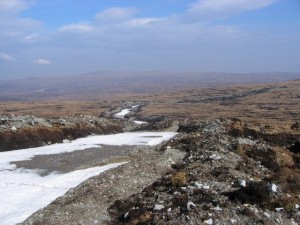
Bulldozed road in Monadhliath, Photo: Richard Webb / CCSA
Deborah Long, Chair of Scottish Environment LINK said: “It is extremely disappointing that the Scottish Government is backtracking on its previous intention to finally bring this unrestrained development into the planning system, a position supported by research from Heriot Watt University. Our fragile upland habitats are now opened up to ever greater proliferation of these tracks and potential long-term damage.
“This relentless attrition of our precious wild land areas from bulldozed hilltracks has been an issue of great concern to LINK members for many years, and has contributed to the shrinking of the extent of land unaffected by visual intrusion in Scotland from 41% to 28% between 2002 and 2009.”
Ms Long added: “While new hilltracks in National Scenic Areas already require planning permission, the majority of land, in our National Parks and elsewhere, continues as fair game for landowners. The proposed amendment to planning legislation would have brought some measure of protection to these areas. Some of these tracks are simply bulldozed through fragile habitats with erosion scars spreading across the landscape, but even well-constructed tracks could be in the wrong place. If these tracks are for legitimate land management purposes then landowners have nothing to fear from bringing them under proper public scrutiny through the planning system.
“While we are disappointed to lose out on this decision, it is Scotland’s natural environment which is the real loser. Responsible landowners should not be using the tired excuse of “an extra bureaucratic burden being added”. They should be acting as custodians of Scotland’s world-famous landscapes for all our benefits.
